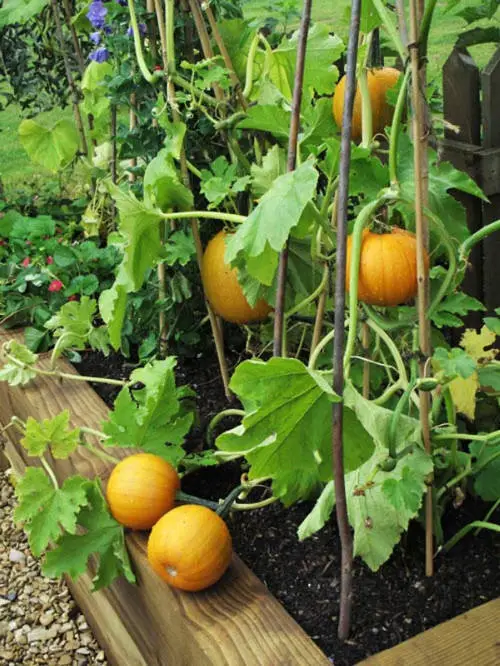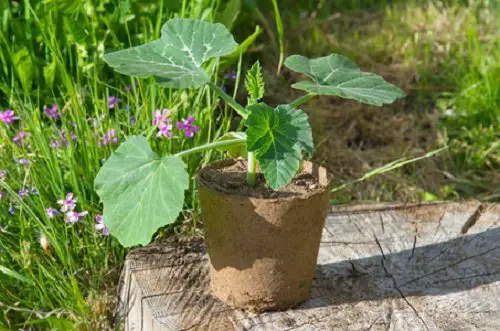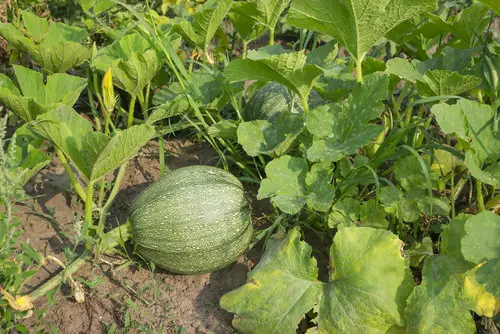Can you grow pumpkins in a container? With our easy Growing Pumpkins in Containers guide, of course, you can!

Pumpkin is valued for its flavor and decorative appearance. Growing Pumpkins in Containers is not so difficult and does not require special care; in fact, it is a less demanding vegetable that adapts to any climate!
How To Grow Pumpkins In Pots
Don’t know how to grow pumpkins in containers? You can grow pumpkins from seeds or buy seedlings from a nursery. Here are the steps for growing a pumpkin in a pot.
1. Choose the Right Container
Select a container that is large enough to accommodate the pumpkin plant’s root system. A 15 to 20-gallon container with good drainage is ideal for growing pumpkins.
2. Prepare the Container
Ensure that the container has drainage holes at the bottom to prevent waterlogging. Don’t know what to put under growing pumpkins? Place a layer of gravel or small rocks at the bottom of the container to enhance drainage.
3. Select the Pumpkin Variety
Choose a pumpkin variety that is suitable for container gardening. Look for compact or dwarf varieties that produce smaller-sized pumpkins, as they are better suited for container cultivation.
4. Use Quality Potting Mix
Fill the container with a high-quality potting mix that is well-draining and nutrient-rich. Avoid using garden soil, as it may not provide adequate drainage and can lead to poor plant growth.
The best potting mix for growing pumpkins in containers is a well-draining blend consisting of equal parts of high-quality compost, peat moss, and perlite or vermiculite for improved moisture retention and aeration.
5. Planting the Seeds
Sow pumpkin seeds directly into the potting mix, about 1 inch (2.5 cm) deep or as mentioned on the seed packet. After planting pumpkins in containers, gently water the soil after planting to ensure good seed-to-soil contact.
Take care of your pumpkins, and soon they’ll be ready to harvest!
Note: In really cool climates, it can be planted from April to late May. Whereas, in slightly warmer climates, it can be done until July. If you live in a frost-free subtropical or tropical climate, you can grow it most of the time of year.
Choosing a Pot for Growing Pumpkin
Choose a large pot that is 15 gallons in volume or at least 16 to 20 inches (for small pumpkin varieties). For large cultivars, the bigger the pot, the better! Just make sure it has a drainage hole at the bottom.
Tip: Consider using a container made of durable materials like plastic or terracotta, as they provide good insulation and help regulate soil temperature.
Best Pumpkin Varieties for Pots

Small pumpkin cultivars are most suitable for container gardening and growing pumpkins in raised beds. However, you can also grow giant pumpkin varieties. Some of the best ones for growing pumpkins in containers are:
- The First Pumpkin: This heirloom variety was initially used to feed cows, and in modern times, it is used to prepare delicious pie pumpkins.
- Lumina Pumpkin: It is similar to the ‘New Moon’ variety. Lumina bears white-colored pumpkins that have smooth skin.
- Porcelain Doll: This variety bears fruits that are unusually pink in color. The medium-sized pumpkin contains bright orange-colored flesh.
- Goosebumps: They initially have smooth skin but gradually develop warts as they grow.
- New Moon: This is one of the bigger varieties with thick white-colored flesh. The New Moon variety derives its name from its white-colored skin.
- Prizewinner: This variety is a super big one. It is capable of bearing large pumpkins that usually weigh between 75 and 150 lbs.
- Baby Boo: Baby Boo is ghost-like white in color and gets its name from its tiny, ‘baby’ size. It grows up to a size of 2-3 inches.
- Sugar Pie: This variety is as sweet as its name but much smaller in size. It is used mainly for baking pies, cookies, and cakes.
- Jack-o’-Lanterns: The medium-based round-shaped pumpkins are an excellent choice for carving.
- Jack-Be-Little: This little pumpkin variety can only grow up to 3-4 inches in shape and takes about 80-90 days to mature. You can plant rows for a bright and bountiful harvest.
Requirements for Growing Pumpkins In Containers

Sunlight
Place the container in a sunny location that receives at least 6 to 8 hours of direct sunlight daily. Pumpkins thrive in full sun, which promotes healthy growth and optimal fruit development.
Low light will slow their growth, and moisture will remain on the plant, attracting mildew. When growing pumpkins in a small space, choose a spot on a balcony, patio, or any area with good sun exposure.
Soil
In cold climates, pumpkins grow best in soil that heats up easily. The potting mix you use for growing pumpkins in containers must be well-draining, have a high humus content, and have a slight water-retaining capacity.
Also, pumpkins require a lot of organic matter like compost or manure, which you can add when planting. A mix consisting of compost, peat moss, and perlite or vermiculite provides good drainage and nutrient retention, ensuring healthy pumpkin growth.
Watering
Keep the soil consistently moist but not waterlogged. Water the container-grown pumpkins regularly, especially during dry periods.
Check the moisture level by inserting your finger into the soil; if it feels dry at a depth of about an inch, it’s time to water. Avoid overwatering, as it can lead to root rot and other fungal diseases.
Temperature and Humidity
Pumpkins prefer warm temperatures between 70 to 85°F (21 to 29°C) during the day and around 60 to 70°F (15 to 21°C) at night.
Maintain a moderate humidity level of around 50% to 70%. Adequate air circulation is essential to prevent fungal diseases, so avoid overcrowding the plants and ensure proper spacing between the pots when growing pumpkins in containers.
Pumpkin Care

Fertilizer
Pumpkin plants are heavy feeders and require extensive fertilization. First, rich soil is important for growing bigger and more meaty pumpkins. In the early stages of growth, balanced fertilizers like 10-10-10 are best.
It is a good idea to switch to a low-nitrogen fertilizer that is rich in potassium and phosphorus, like water-soluble 5-15-15 fertilizer, every other week (when the plant has grown and is big enough to produce flowers).
Pruning
Regular pruning helps maintain the health and productivity of container-grown pumpkins. Trim off any yellow or diseased leaves, as well as excessive vine growth, to promote airflow and reduce the risk of fungal diseases.
You should pinch off the ends of the vines once the plant has set enough pumpkins to redirect energy for better fruit development.
Support
Pumpkin grown in containers need support. To prevent them from sprawling on the ground and to promote better air circulation, you can use trellises, stakes, or cages. As the growing pumpkins vertically, gently tie the vines to the support structure using soft garden twine or plant clips.
An A-shape trellis is a good choice for growing pumpkins on a trellis. Supporting the vines helps prevent breakage, enhances fruit visibility, and reduces the risk of soil-borne diseases.
Pests and Diseases
Monitor the pumpkin plants regularly for common pests like aphids, squash bugs, or vine borers. Use organic pest control methods such as hand-picking or spraying with neem oil for growing pumpkins in containers to manage pest infestations.
Additionally, watch out for fungal diseases such as powdery mildew or downy mildew. Ensure good air circulation, avoid overhead watering, and treat with appropriate organic fungicides if necessary.
Harvesting Pumpkins

Pumpkins are ready for harvest within 90-120 days after planting (depending on the varieties and growing conditions).
Harvesting pumpkins grown in containers requires careful observation and timing. Wait until the pumpkin’s skin has hardened and reached its desired color, typically a deep, vibrant shade. The stem attached to the pumpkin should also have dried and become tough.
To pick the pumpkin, remove it carefully from the branch using pruning shears or a sharp knife. However, do not cut too close to the fruit; to extend the shelf life, leave a long stem (about 10 cm).
Harvesting Tip: Press the pumpkin with your thumb — if the bark is hard and it sounds hollow, it is time to pick the fruit. The bark should also resist nail pressure. Allow the harvested pumpkins to cure in a warm, dry area for about two weeks to enhance their flavor and increase their shelf life.
Tips on Growing Pumpkins In Containers
- You should plant pumpkins directly in containers. However, if you choose to start with seeds indoors, consider using biodegradable pots for easy transplantation.
- Without bees or other pollinators, hand pollination may be necessary to ensure fruitful harvests. Gently transfer pollen from male flowers to the stigma of female flowers, allowing the plant to set fruits.
- Male flowers typically bloom first and attract pollinators, but they only last for a day. Following them, female flowers open, with a small swelling at the base.
- Thinning the fruits by removing the smaller or misshapen ones allows the plant to direct more energy toward producing larger, higher-quality pumpkins.



Hi,
This is very helpful!
What do I do when the plant keeps on growing? I know how big it can get.. Can I just trim it? Because I think that would kill the plant. Or can I just keep the plant grow around itself on the support sticks?
And how do I choose which fruit I want to keep and which one has to go? And can I just cut these?
Thanks in advance!
Hi Geeke
I grow my JAP pumpkins on a trellis and removed the end of the tendrils about 30 cm after the fruit (once it has set of course). I also use a more porus soil as my pots sit over a fish pond. I then water once a day using the water from the pond. Any excess water then runs out and back into the pond.
No you should not trim it,just leave it but those other plant you don’t want uproot them out
I appreciate this article and advice very much. Thank you. I have a couple pumpkin plants in my greenhouse (Big Max and White Casper) and your tips have given me much insight on how to care for them. The main vines are both quite long now, I would say about 7-8 feet so far. They are beginning to crowd some other plants now so I’ve been concerned on how to deal with that. I’ve read a few articles on how to stop the vine growth so that they may be able to focus on fruit development over length/vine growth and most seem to say that I should cut the tips off to stop the growth and bury the end in the soil to prevent disease. My pumpkins are not in pots, they are in the ground, however I was wondering what your thoughts are. Should I cut the tips and bury the cut ends in the soil to stop their lengthwise growth? Thank you so much for your help and insight. I appreciated reading your article. Have a great and plentiful Fall season!
Here in Florida during the summer, we get almost daily afternoon thunderstorms with hard, pelting rain which destroys the tender leaves by riving them into the ground and tearing them up. Is there any way to combat this? Also, what is the best all around pesticide to use on pumpkns?
very nice n lovely
Thankyou for this wonderful article, I’m a total novice and only have a small front garden (with totally crappy soil that’s no good for planting ) so I’m doing everything in pots I’ve just scraped out the pumpkin seeds and I’ve got them out to air dry and prepare ready for planting in April ( I’m so excited as its really helping me with my mental health ) this article as been so helpful